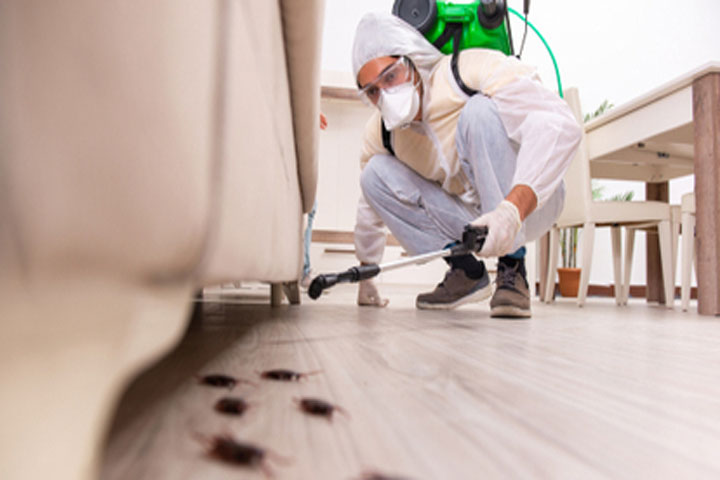Chicago Spider Extermination Services: Safe and Reliable Removal
Chicago Spider Extermination Services: Safe and Reliable Removal
Blog Article
A Comprehensive Guide to the Different Types of Pest Control Methods
With the myriad of insect control methods readily available, it can be overwhelming to find the most reliable option for a certain insect issue. In this extensive overview, we will explore these various types of parasite control techniques, providing understandings into their applications and advantages. By the end, you will have a more clear understanding of which technique may be the ideal fit for your pest control requirements.
Chemical Bug Control Approaches

One typical kind of chemical parasite control is pesticides. Pesticides are chemical compounds that are especially formulated to kill or repel insects. They can be used in numerous kinds, such as sprays, baits, or dusts. Insecticides target details parasites, such as insects, termites, or ants, and can be utilized both inside your home and outdoors.
An additional type of chemical parasite control is rodenticides. These are chemical compounds designed to regulate populations of rats, such as rats and mice.
Herbicide, likewise referred to as herbicides, are one more kind of chemical bug control method. Herbicides are made to precisely eliminate unwanted plants, referred to as weeds, without triggering harm to preferable plants. They are typically used in farming, landscaping, and horticulture to control the development of unwanted vegetation.
While chemical pest control approaches can be extremely effective in eliminating bugs, it is essential to use them sensibly and adhere to security guidelines. Overuse or abuse of chemical pesticides can have unfavorable influence on human wellness and the environment. It is vital to use these methods responsibly and think about alternate parasite control methods whenever possible.
Biological Bug Control Approaches
Organic parasite control methods involve making use of living microorganisms or all-natural materials to take care of and regulate pest populations. Unlike chemical methods, which typically depend on artificial chemicals, organic control approaches make use of the all-natural adversaries of pests to regulate their populations. This method is taken into consideration more eco-friendly and lasting, as it minimizes the use of unsafe chemicals and reduces the threat of pesticide resistance.
One widely utilized organic parasite control technique is the intro of all-natural killers or bloodsuckers. As an example, ladybugs are presented to regulate aphids, while certain wasp varieties are released to target caterpillars. These killers and parasites eat insects, minimizing their numbers and preventing invasions.
One more biological control technique is the use of microorganisms. Particular microorganisms, infections, and fungis can be utilized to infect and kill specific pests. For instance, the microorganism Bacillus thuringiensis is frequently made use of to control caterpillars, as it creates contaminants that are dangerous to these parasites.
Biological control techniques can also include the use of scents or natural materials that disrupt the breeding patterns of insects. By conflicting with their reproduction, these approaches help to lower pest populations gradually.
While biological bug control methods are normally effective, they might call for longer periods to accomplish wanted results contrasted to chemical approaches. Furthermore, mindful consideration needs to be given to the choice and launch of natural opponents to protect against unplanned harm to valuable organisms or ecosystems.
Physical Bug Control Methods
To efficiently handle and manage pest populaces, alternative pest control methods known as physical pest control methods are utilized. Another physical bug control method is the setup of fencings or walls to maintain bigger insects, such as deer or rabbits, out of yards or farming areas. Physical bug control methods are an ecologically friendly option to chemical pesticides, as they do not rely on the use of unsafe chemicals.
All-natural Bug Control Techniques
All-natural pest control techniques offer a lasting and environment-friendly approach to managing and eliminating parasites. These approaches prioritize making use of natural substances and organic representatives, decreasing the need for chemical pesticides that can hurt the environment and human health and wellness. One of one of the most typical all-natural pest control techniques is organic control. This entails presenting natural killers or parasites to victimize or parasitize the parasites. Ladybugs are often presented to yards to manage aphid populations. One more natural technique is the use of repellents originated from plants. Specific plants, such as marigolds, lavender, and pepper mint, give off fragrances that fend off bugs like insects, flies, and ants. discover this Furthermore, social control methods can be employed to avoid and manage parasite invasions. This includes proper hygiene, normal maintenance, and advertising biodiversity in the yard. For instance, revolving plants, eliminating yard particles, and encouraging natural killers can help stop the buildup of insects. By embracing these natural bug control methods, individuals and areas can successfully take care of parasites while minimizing the negative effect on the atmosphere and human health and wellness.
Integrated Parasite Management (IPM)
Integrated Bug Monitoring click resources (IPM) is a detailed and organized technique to pest control that integrates numerous approaches and methods to efficiently manage insects while decreasing the use of chemical pesticides. IPM aims to keep parasite populaces below the financial injury degree by making use of a mix of cultural, biological, and chemical control techniques.
Social control methods entail modifying the atmosphere to make it less favorable for parasites. This can consist of techniques such as crop turning, appropriate sanitation, and the usage of immune plant varieties. By creating unfavorable conditions for insects, cultural control techniques can considerably reduce bug populations.

Chemical control techniques are made use of as a last resort in IPM. They entail the targeted and judicious usage of chemicals to take care of bug populations. Unlike conventional parasite control techniques, IPM intends to decrease using chemical pesticides by utilizing different methods.
Integrated Pest Monitoring (IPM) is a proactive method that focuses on long-lasting pest management as opposed internet to counting exclusively on reactive actions. By combining numerous control approaches, IPM provides an extra lasting and eco-friendly technique to pest control.
Conclusion
It went over chemical, organic, physical, and all-natural pest control methods, as well as the integrated bug management method. By comprehending these different methods, individuals can make educated decisions on which bug control method is most appropriate for their certain demands and preferences.
Report this page